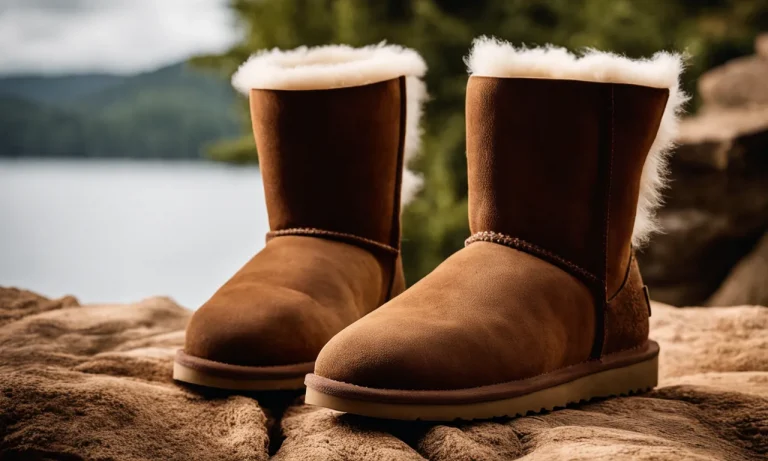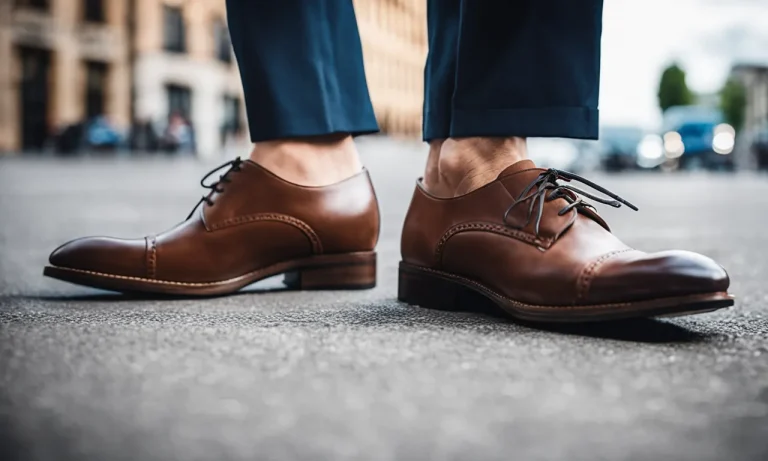If you’ve invested in a good pair of leather boots, taking proper care of the leather is crucial for longevity. Mink oil is a popular leather conditioner that can help moisturize and protect your boots, but how exactly should you use it?
If you’re short on time, here’s a quick answer: Mink oil penetrates deep into the leather pores to condition from within and prevent cracks. Use it sparingly every 4-6 months, apply with a clean cloth, let it soak in overnight, then buff away excess.
What is Mink Oil?
Mink oil is a popular product used for conditioning and protecting leather goods, especially boots. It is a natural oil derived from the fat of minks, a small mammal native to North America, Europe, and parts of Asia.
Mink oil has been used for centuries due to its unique properties that help maintain the quality and durability of leather.
Made from mink fat
Mink oil is extracted from the fat of minks through a process called rendering. The fat is carefully collected, purified, and processed to create a high-quality oil that can be used for various applications, including leather care.
Mink oil is known for its purity and effectiveness in nourishing and protecting leather surfaces.
Penetrates and conditions leather
One of the key benefits of mink oil is its ability to deeply penetrate the leather fibers, providing essential moisture and nutrients. This helps to prevent drying, cracking, and fading, keeping the leather soft, supple, and looking its best.
Mink oil also helps to restore the natural oils that may be lost over time, rejuvenating the leather and extending its lifespan.
Provides water resistance
Mink oil is highly effective in providing water resistance to leather boots. When applied to the surface, it creates a protective barrier that repels water, preventing it from seeping into the leather and causing damage.
This is particularly beneficial for outdoor enthusiasts, as it helps to keep their boots dry even in wet and muddy conditions.
It is important to note that mink oil may darken the color of some leathers, so it is recommended to test it on a small, inconspicuous area before applying it to the entire boot. Additionally, mink oil should not be used on suede or nubuck leather, as it can alter the texture and appearance of these materials.
Benefits of Using Mink Oil
Mink oil is a popular choice for leather enthusiasts when it comes to maintaining the quality and longevity of their boots. Here are some of the key benefits of using mink oil:
Softens and moisturizes leather
Mink oil is known for its excellent moisturizing properties. When applied to leather boots, it penetrates deep into the material, softening and moisturizing it from within. This helps to keep the leather supple and prevents it from becoming dry and brittle over time.
By keeping the leather well-nourished, mink oil helps to maintain the natural beauty and flexibility of the boots.
Prevents cracks and drying
One of the primary concerns with leather boots is the risk of cracks and drying. Exposure to harsh elements and frequent use can cause the leather to lose its natural oils and become prone to cracking.
However, mink oil acts as a protective barrier, preventing moisture loss and minimizing the chances of cracks and drying. Regular application of mink oil can help prolong the lifespan of your boots by keeping them in excellent condition.
Restores suppleness
If your leather boots have lost their suppleness and feel stiff, mink oil can come to the rescue. Its conditioning properties help to restore the natural flexibility and softness of the leather. By replenishing the moisture content and nourishing the material, mink oil can revive even the most worn-out boots and make them feel like new again.
Protects against salt, dirt, and moisture
When you wear leather boots, they are exposed to various external elements such as salt, dirt, and moisture. These can cause damage and discoloration to the leather if not properly protected. Mink oil forms a protective layer on the surface of the boots, acting as a barrier against these elements.
It helps to repel water, prevent stains, and keep the boots looking clean and fresh for longer.
Extends the life of boots
Investing in a good pair of boots can be quite expensive, so it’s important to take proper care of them to ensure they last. Regularly treating your boots with mink oil can significantly extend their lifespan.
By keeping the leather well-maintained, mink oil helps to prevent premature aging and deterioration. This means you can enjoy your favorite pair of boots for years to come, saving you money in the long run.
It’s worth mentioning that while mink oil offers numerous benefits for leather boots, it’s important to follow the manufacturer’s instructions and ensure you’re using it correctly. Additionally, it’s always a good idea to test the mink oil on a small, inconspicuous area of your boots before applying it all over to ensure compatibility and avoid any potential discoloration.
How to Apply Mink Oil to Boots
Clean boots first
Before applying mink oil to your boots, it is important to clean them thoroughly. Use a soft brush or cloth to remove any dirt or debris from the surface. You can also use a leather cleaner or mild soap mixed with water to gently clean the leather.
This step ensures that the mink oil will be able to penetrate the leather effectively.
Apply sparingly with a clean cloth
Once your boots are clean and dry, it’s time to apply the mink oil. Take a clean cloth and apply a small amount of mink oil to it. It’s important to apply the oil sparingly, as using too much can lead to a greasy finish. Start with a small amount and add more if necessary.
Massage into leather and let soak overnight
Using the cloth, gently massage the mink oil into the leather in circular motions. Make sure to cover the entire surface of the boots, including the seams and creases. After applying the oil, allow the boots to sit overnight to let the mink oil fully penetrate the leather.
This will help to nourish and moisturize the leather, providing it with a soft and supple feel.
Buff away excess mink oil
The next day, take a clean cloth and gently buff away any excess mink oil from the surface of the boots. This step helps to remove any residue and ensures a smooth finish. It also prevents the boots from feeling sticky or greasy.
Allow 24 hours to fully absorb
After buffing away the excess oil, it’s important to allow the boots to fully absorb the mink oil. This process can take up to 24 hours, so be patient. Avoid wearing the boots or exposing them to moisture during this time.
Once the mink oil has fully absorbed, you can enjoy the benefits of its nourishing properties.
Remember, mink oil is a great way to condition and protect your boots, but it’s important to follow these steps carefully for the best results. By properly applying mink oil, you can extend the lifespan of your boots and keep them looking great for years to come.
How Often Should You Use Mink Oil?
Mink oil is a popular choice for conditioning and protecting leather boots. It helps to moisturize the leather, preventing it from drying out and cracking, and also provides a waterproof barrier. But how often should you use mink oil to keep your boots in top condition?
Let’s take a look at some guidelines.
Every 4-6 months for prevention
To maintain the quality of your leather boots, it is recommended to use mink oil every 4-6 months as a preventative measure. Regular application of mink oil will help keep the leather soft, supple, and resistant to water damage.
This frequency is especially important if you frequently wear your boots or expose them to harsh weather conditions.
After exposure to heavy rain or salt
If your boots have been exposed to heavy rain or salt, it is advisable to apply mink oil after they have dried. These elements can strip away the natural oils in the leather, leaving it vulnerable to cracking and damage.
Applying mink oil after exposure to moisture or salt will help restore the leather’s moisture and protect it from further harm.
When leather is dry or cracked
If you notice that your leather boots are becoming dry or cracked, it’s a clear sign that they need some extra care. In such cases, applying mink oil can help restore the moisture and flexibility of the leather, preventing further damage.
Make sure to clean the boots thoroughly before applying the oil to ensure maximum absorption.
Remember, the frequency of mink oil application may vary depending on the quality of your boots, how often you wear them, and the environmental conditions they are exposed to. It’s always a good idea to follow the manufacturer’s recommendations and keep an eye on the condition of your boots to determine when they need a fresh coat of mink oil.
Tips for Using Mink Oil
Test first on small hidden area
Before applying mink oil to your boots, it is always a good idea to test it on a small, hidden area first. This will help you determine if the mink oil will have any adverse effects on the material of your boots.
Apply a small amount of mink oil to an inconspicuous spot and wait for a few hours to see if there are any changes in color or texture. If everything looks good, you can proceed with applying the mink oil to the rest of your boots.
Avoid over-application
While mink oil can work wonders for conditioning and moisturizing your boots, it is important to avoid over-application. Applying too much mink oil can lead to an oily residue that may attract dirt and grime.
Additionally, excess mink oil can saturate the material of your boots, causing them to become overly soft and lose their shape. Remember, a little goes a long way when it comes to mink oil, so apply it sparingly and evenly.
Store in cool, dry place
Proper storage of your mink oil is essential to maintain its effectiveness. Make sure to store the mink oil in a cool, dry place away from direct sunlight. Exposure to heat and sunlight can cause the mink oil to break down and lose its conditioning properties.
Keeping it in a tightly sealed container will also prevent any contaminants from getting into the oil and affecting its quality.
Consider weatherproofing sprays for added protection
While mink oil can provide some level of water resistance, it may not be enough to fully protect your boots in heavy rain or snow. To give your boots an extra layer of protection, consider using a weatherproofing spray.
These sprays create a barrier on the surface of your boots, helping to repel water and keep your feet dry. Look for a spray specifically designed for the material of your boots, such as leather or suede, for best results.
Conclusion
Mink oil is an effective leather conditioner that can help keep your boots supple and protected. Use it sparingly every 4-6 months to moisturize the leather, prevent drying and cracking, and extend the life of your boots.
With proper care using mink oil and weatherproofing sprays, your boots will last for years to come.






